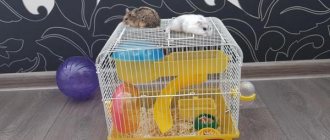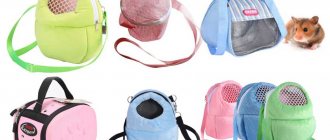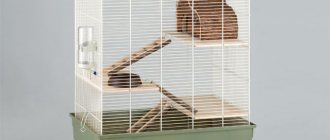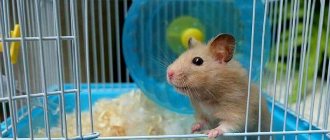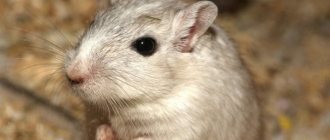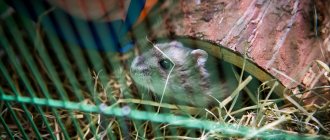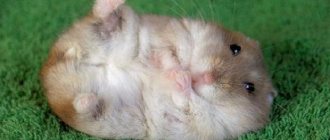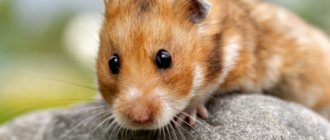An important condition for a long and happy life for a hamster is a properly equipped cage with high-quality bedding. To make a good bedding for a rodent, you need to choose the right litter for hamsters and cover the bottom of the cage with it, it can be sawdust, toilet paper, or small granules. Good bedding for a hamster's cage is no less important than quality food.
What is best not to use as bedding for a hamster?
Under no circumstances should silicate fillers be used in a hamster's cage. When wet, the substances contained in it corrode the skin on the paws and mucous membranes of the mouth of hamsters.
Fillers with traces of printing ink are also unsafe for hamsters. The strong poisons contained in it injure the digestive system of rodents.
Extreme caution should be used when using fillers that contain large, dense particles with sharp edges or that can form sharp edges when the filler is chewed. The hamster may get hurt.
An undesirable type of filling is fabric or cotton wool. For a small pet, dense threads can be fatal: it gets tangled in the threads, injures its paws and can even suffocate.
How to choose materials for a hamster house
If you want to build a house for a rodent, you should focus on the durability of the structure. So, a home built from cardboard will not last long. It will only be a temporary shelter. A structure made of wood is more reliable, but a pet can chew it quickly enough. The strongest houses are made of glass, food-grade plastic and ceramics. They are reliable, durable, easy to wash during cleaning and clean from dust.
Lego structures, hollow parts from children's toys, glass and plastic jars and containers, etc. can be used as housing for a hamster.
A house made from a stand for toothbrushes or stationery will look original.
Types of fillers for rodent cages
- Sawdust of varying degrees of grinding and compaction,
- Paper,
- Specialized cat litters,
- Hay or straw, rags.
Let's look at the pros and cons of each filler.
Wood sawdust
The general rule for filling cages with sawdust is to use fruit and soft hardwoods. They do not have a strong odor and do not emit resins, which can cause the filler to stick to the animal's skin and cause digestive problems.
Sawdust
The cheapest, most practical and safest filler for a hamster cage.
Pros:
- Availability - available in any pet store or supermarket that sells pet products.
- Environmentally friendly - sawdust does not contain any impurities, dyes, or chemical compounds.
- Animal safety. The fine fraction of sawdust allows you to rummage through it and does not injure the hamster.
- Low cost sawdust filler
Minuses:
- The sawdust is small, it easily spills out of the cage and produces a lot of dust and debris.
- They can cause allergies in your pet, manifested by sneezing and watery eyes.
- Small particles become clogged in the hamster's fur, which leads to the need to comb the animal.
- This bedding should be changed at least once every 3-4 days, depending on the volume of the cage..
Are you ready to clean the cage every 2-3 days?
Packaging shavings
An option for sawdust filler is soft wood shavings, which are used when packing fragile objects for transportation. As a bedding, it solves some of the disadvantages characteristic of sawdust:
- Almost does not get stuck in the animal's fur,
- Produces less dust
- It looks very aesthetically pleasing.
However, there are also disadvantages:
- Gets dirty quickly
- Requires more frequent changes
- Packaging shavings are more difficult to obtain.
Large chips
Large chips are obtained at sawmills after the operation of an electric planer and are often sold in large packages of 20 kg. The main advantages of large chips:
- maximum decorativeness,
- persistent woody aroma,
- softness,
- imitation of the natural habitat of rodents with shavings - the animals will be happy to hide in it.
The disadvantage of large chips is their low availability in the city.
Granules (pellets)
Granules or pressed sawdust have an incomparable advantage over conventional ones:
- They do not crumble much during storage and do not produce as much dust as sawdust.
- I absorb moisture and odors better and longer – up to 7 days without changing.
- The large fraction does not allow the hamster to scatter granular sawdust around the cage.
Minuses:
- higher cost,
- Large granules make the hamster somewhat uncomfortable at first,
- a certain amount of dust is generated.
wood chips
Wood chips in cages with hamsters are used much less frequently due to their significant disadvantages:
- Such filler is traumatic for the animal. Large fractions can injure the hamster when he rummages through the wood chips.
- Wood chips absorb liquids and odors much worse; some of the liquids will collect at the bottom of the cage.
Cat litter
Use cat litter in cages with hamsters very carefully and for a short time. Be sure to read the composition of the product before purchasing. You must make sure that the filler does not contain any fragrances, flavors or food additives . Hamsters will definitely chew any filler granules, and it is necessary to ensure their safety.
Wood filler
Wood litter for cat litter is completely identical in structure to granules or pellets. It can be used in cages with hamsters; the only drawback may be the slightly larger size of the granules.
Lumpy clay litter
It is recommended to choose a filler with a minimum granule diameter. Hamsters are not particularly happy with this type of bedding. In addition, clay is prone to spreading when moistened and greatly stains the rodent's paws and coat.
Cellulose filler
Minuses:
- low prevalence.
- poor ability to retain liquid and odor.
Pros:
- For hamsters intolerant to wood dust, this is the optimal type of bedding.
- Doesn't get tangled in wool
- Does not cause allergies in animals and people.
Corn filler
The main advantage of corn filler is its amazing ability to absorb liquids and odors. The filler consists of crushed and pulverized corn fibers. The porous composition allows the hamster to build burrows and nests.
The disadvantage of corn litter is its high cost.
Silica gel filler
This type of litter should be used in cages with double bottoms. It is placed under the grate so that the hamster does not have access to it. The urine is absorbed by the silica gel filler and the odor is firmly sealed in the capsules. You can clean the cage once every few weeks, since the filler is designed for a large volume of absorption.
Bedding made from scrap materials
Scrap bedding includes anything you have around the house that can be shredded and used for soaking. This method is not often used - if the hamster was suddenly given as a gift or someone forgot to buy a special filler.
Paper napkins
Shredded paper napkins are selected without a typographic design.
Pros:
- Soft and safe,
- Excellent absorption and retention of moisture and odor,
- Easily replaced
- They cost a minimum.
Disadvantage of napkins:
- Unattractive appearance.
Toilet paper
Toilet paper, preferably unbleached, is a universal and high-quality filler, which, unfortunately, has a dubious aesthetic appearance.
- The paper quickly absorbs and retains excrement and odor,
- Very cheap
- Maximum safe.
Minuses:
- Daily change of litter is required.
- Unaesthetic.
cotton wool
Strong cotton wool fibers are not the best bedding for your pet. They are not safe:
- the paws will become entangled in strong fibers and the animal may be injured,
- Swallowing cotton wool leads to digestive problems.
Cotton wool is much inferior to other fillers in terms of aesthetic properties: white and loose when loaded into the cage, after a short time it becomes covered with yellow and brown spots and looks extremely untidy.
Fine sand
Sand absorbs liquid well and dries quickly, but does not effectively retain odors. In addition, purchasing sand is difficult, and it is difficult to get guaranteed clean sand that is not contaminated with worms in the city.
Rags
Veterinarians do not recommend using rags as bedding or litter for hamsters. Shredded rags produce many strong threads in which the hamster can become entangled and die.
Newspaper
The main disadvantage of newspaper filler is printing ink, which contains a huge amount of toxic compounds. The hamster will definitely chew the bedding and all the poisons will enter the body and accumulate in it , significantly shortening the already short life of the rodent.
Hay, straw
Hay and straw are considered the most natural of all hamster cage litters. At home, you can make hay yourself or purchase a package of ready-made hay. If you decide to harvest it yourself, please note that you cannot take grass for hay near highways or other contaminated places.
Pros of hay:
- Available and in some cases free,
- Closest to the habitat
- Suitable for building a nest by a hamster,
- Part of it will be eaten as a wonderful delicacy.
Downside of hay:
- Poorly absorbs odors
- Requires frequent replacement - once every couple of days.
Blank paper
Using white office paper as bedding is, firstly, unsafe for your pet, and secondly, useless. Office paper has sharp, hard edges, and it should not be placed in the cage without carefully crumpling it , as the hamster may be injured when chewing and tearing the sheets. In addition, the density of the paper does not allow it to quickly absorb liquids - the bottom of the cage will be constantly wet, and the smell will be the same as if you had not used bedding at all.
Linen
Linen bedding is a relatively new invention, but effective:
- Exceptionally high absorbency,
- Environmental friendliness,
- Low dust levels,
- The top layer always remains dry thanks to its high breathability.
Minuses:
- High price,
- Low availability.
Clay bedding
Allows for spot cleaning of the cage, since the clay in places where it gets wet becomes compressed and darkens. Simply remove the lump and add fresh filler.
Minus:
- When wet, it greatly stains the rodent's paws and fur.
Newspapers
Apparently, this still relatively popular filler option is a legacy of those times when hamsters were kept in three-liter jars and fed cabbage and bread crusts. But if at that time such a choice for caring for an animal could still be explained (after all, there was no choice at all, other options for fillers used were no better than scraps of newspaper), now it seems simply amazing.
And it’s not just that printing ink, to put it mildly, is harmful to the hamster. This filler option does not fulfill its main function: it does not retain moisture and odor at all. And as a result, the little animal successfully spoils its health while it sleeps in newspaper scraps or chews them into shreds, and the smell from the cage is the same as from a cage without any filler at all.
Photo: Depositphotos
In other words, this filler does not have a single positive characteristic at all, since it is difficult to call it a filler.
Price of fillers
What is the best filler for a hamster cage? The comparison table shows the average prices for different types of filler and indicates the approximate service life of the filler per fill.
| Filler | Cost, 10 liters | Backfill service life |
| Sawdust | 150 rubles | 3-5 days |
| Granular filler | 450 rubles | 5-7 days |
| Straw | 250 rubles | 2-3 days |
| Corn filler | 500 rubles | 7-9 days |
| Hay | 400 rubles | 2-3 days |
| Napkins, toilet paper | 10 rub. per pack | 1-2 days |
Ceramic houses
Relatively recently, housing for rodents made of ceramics has appeared on sale. This material is safe in terms of toxicity, retains heat well, but is much more expensive than housing made of plastic or wood. A ceramic house, in addition to its high cost (from 300 rubles), has another inconvenience: if it falls from a height, it can break. Therefore, when cleaning your pet’s cage, you must ensure that the “bedroom” does not fall.
Houses made from this material have very original designs, colors and sizes. You can find housing for rodents in the form of vegetables or fruits. A small pumpkin with one entrance and no windows looks especially beautiful. A house in the shape of a “piece of cheese” with holes in its walls will become not only a place for the animal to sleep, but also a fascinating labyrinth.
Sawdust
Perhaps this is now the most popular type of litter for all types of rodents. Bags of sawdust are inexpensive and are sold almost everywhere. The moisture and smell of sawdust are poorly retained, but they are retained.
So, you have to change the filler in the cage of a Syrian hamster, if it lives in sawdust, every 2-4 days, that is, just after 2-4 days the cage begins to smell unpleasant.
However, sawdust also has a number of significant disadvantages :
- In long-haired hamsters, they get tangled in the fur, forming tangles, so they have to be cut and combed every day.
- If a hamster collects sawdust in its cheek pouches (either intentionally or accidentally), it has a good chance of scratching its cheek pouch and even dying due to infection.
- There are hamsters who are allergic to wood dust; for them, sawdust is a source of constant discomfort.
- Another disadvantage of sawdust, which is significant for the owner of a hamster, is that the sawdust is very light, so from under the paws of a running hamster they scatter literally throughout the entire room in which the cage is located.
Blank paper
It’s worth making a reservation: “it depends.” There is no place for hard paper with “sharp” edges in a hamster’s cage—chewing it can cause injury to the animal. But clean white napkins, paper handkerchiefs or toilet paper (unscented) are excellent materials for nest building. They can be chewed into paper dust, fluffed up like a feather bed... And the animal will sleep in such a nest both warmly and comfortably.
However, this is also not a filler, since soft napkins and handkerchiefs perform the main function of a filler not much better than torn newspapers - they do not retain moisture or odor.
What else can surprise the “fluffy”?
Djungarian and Syrian hamsters, like the rodents of Roborovsky and Campbell, like to live in houses wicker from vine branches. Such dwellings look original against the background of the bars of the cage.
In pet stores you can find sleeping hammocks made of soft fabric with foam lining. Such devices are suspended from the bars of the cage. Sometimes soft bedrooms are shaped like a tent or a lounger with a hood. The advantage of such “cribs” is the presence of a bottom. Therefore, you don’t need to think about what to put in the cage: sawdust, shavings, paper, a napkin, a piece of fabric.
The hamster does not care how much the house costs or what material it is made of. A pet will appreciate much more the care and attention that loving owners will provide it with.
Once you see funny hamsters from friends or in a pet store, you may have a desire to buy such an entertaining animal for yourself. Before you give in to this impulse, be sure to prepare yourself.
To do this, you need to purchase a suitable cage, equip it with the necessary things , buy him special food, and only then get a pet. In this article we will figure out what should be in a hamster’s cage.
